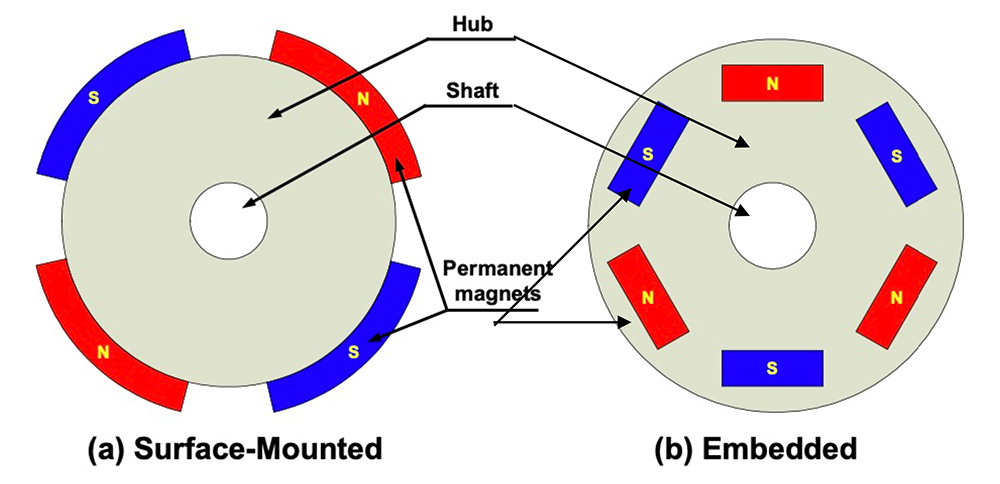What Are You Looking For?
What Are You Looking For?
The driving heart of new energy vehicles, NdFeB magnets optimize torque density and energy efficiency.
Payment :
100% in advanceProduct Origin :
ChinaShipping Port :
XIAMENLead Time :
30-35 daysWeight :
Base on the productionProduct Information
Magnet: Arc Sintering NdFeB Magnet
Coating: Epoxy / Other Coating
Shaft: 304 / Other Metal Shaft
Assembly: Glue And Silicon Steel Sheet
Runout/Concentricity: 0.1mm (Discussable)
What is a magnetic rotor?
IPM stands for Interior Permanent Magnet motor. It is a type of electric motor that combines the features of both Permanent Magnet (PM) motors and Induction motors. Rotor magnet position can significantly alter the electrical properties of a PMSM, mounting the rotor magnets on the surface -as shown in Figure(a)-results in lower torque ripple, while burying the magnets inside the rotor structure-as shown in Figure(b) increases saliency, which increases the reluctance torque of the motor. In an IPM motor, permanent magnets are embedded in the rotor, creating a magnetic field. IPM rotor interacts with the stator windings, which are supplied with alternating current (AC). The interaction between the magnetic field of the rotor and the rotating magnetic field of the stator induces a torque, causing the motor to rotate.
Analysis of key performance parameters of NdFeB rotors:
The performance of NdFeB magnetic rotors is determined by a number of key parameters, which directly affect the efficiency and reliability of the rotors in practical applications. A deep understanding of these technical indicators is essential for the correct selection and use of NdFeB rotors.
Table: Comparison of Key Performance Parameters for Different Types of NdFeB Rotors
| Parameter Type | Performance Indicator | Sintered NdFeB Rotor | Injection Molded NdFeB Rotor | Bonded NdFeB Rotor |
|---|---|---|---|---|
| Magnetic Properties | Remanence (Br) | 1.0-1.4 T | 0.55-0.80 T | 0.55-0.80 T |
| Coercivity (Hcb) | 800-2000 kA/m | 285-800 kA/m | 285-1440 kA/m | |
| Maximum Energy Product (BH)max | 35-52 MGOe | 7-15 MGOe | 5.5-11.5 MGOe | |
| Temperature Characteristics | Operating Temperature | 80-200°C | 120-180°C | 100-150°C |
| Curie Temperature (Tc) | 310-370°C | 310-350°C | 310-350°C | |
| Physical Properties | Density | 7.4-7.5 g/cm³ | 5.0-6.1 g/cm³ | 5.8-6.2 g/cm³ |
| Mechanical Strength | Highly brittle | Good | Good |
Notes:
1. Remanence (Br): Indicates residual magnetic flux density after external magnetic field is removed.
2. Coercivity (Hcb): Reflects resistance to demagnetization (higher values = better stability).
3. Maximum Energy Product (BH)max: Measures magnetic energy storage capacity (critical for motor power density).
4. Curie Temperature (Tc): The temperature at which the material loses all magnetic properties.
5. Density: Affects rotor weight and inertia (lower density in bonded/injection molded types due to polymer content).
Manufacturing Process and Technical Features:
The manufacturing process of NdFeB magnetic rotors directly affects their performance characteristics, production costs and application scope. There are three main manufacturing process routes on the market: sintering process, bonding process and injection molding process. Each process has its unique technical characteristics and applicable scenarios. A deep understanding of the differences between these manufacturing methods is crucial for the correct selection and design of NdFeB rotors.
Table: Comparison of Three NdFeB Rotor Manufacturing Processes
| Process Type | Sintering Process | Bonding Process | Injection Molding Process |
|---|---|---|---|
| Process Flow | Ingredients → Melting → Powder making → Pressing → Sintering → Machining → Surface treatment → Magnetization | Magnetic powder + binder → Mixing → Molding → Curing → Magnetization | Magnetic powder + plastic → Mixing → Injection molding → Magnetization |
| Magnetic Properties | Highest (Max energy product 35-52 MGOe) | Medium (Max energy product 5.5-11.5 MGOe) | Medium (Max energy product 7-15 MGOe) |
| Mechanical Characteristics | Brittle, difficult to machine | Good, allows complex shapes | Excellent, allows complex shapes |
| Dimensional Accuracy | Low, requires secondary machining | High, near-net shape | Very high, net shape |
| Cost Characteristics | High (especially for complex shapes) | Medium | Low (for mass production) |
| Typical Applications | High-performance motors, wind turbine generators | Micro motors, sensors | Automotive motors, pump motors |
Q&A
Q: Why is the magnetic component I received different from the picture on the website?
A: This is our latest style. The one on the web page was sent up before and has not been updated.
Q: Quality and raw materials. Can you prove that your products are safe and standard?
A: Our product meet your requirements. We can provide material safety certificate, Rosh, REACH certificate, appearance inspection certificate and so on.
Q: Do the magnets you make meet international standards?
A: The magnets we make meet international standards. We have all the certificates.
Q: What will you do if there is a quality problem?
A: If you have any problem after receiving the magnet, please contact us immediately and shoot a video to us. We make records and take pictures of all the details when we ship. If it's our fault, we'll take the blame. If it happened in transit, we are not responsible for it.
Tel: +8615159285126 Email: sales@kingsmagnet.com